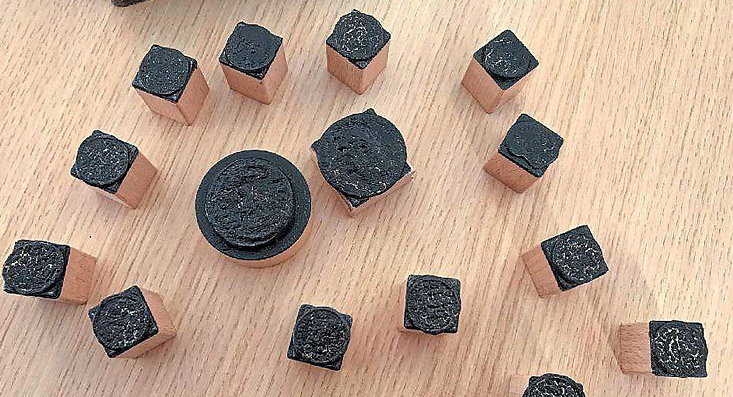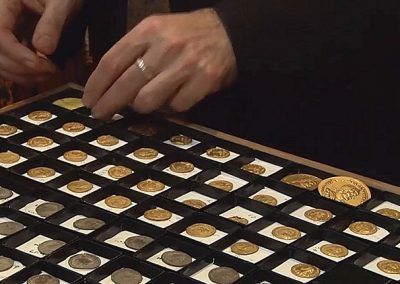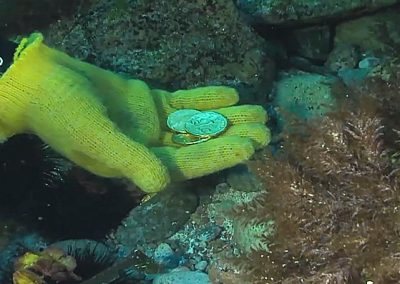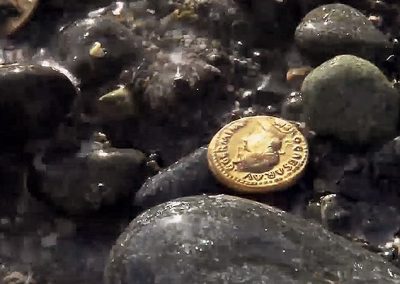
Bible, History, Archaeology
Bible,
History,
Archaeology
The treasure of Lava in Corsica
Contents:
Discovery – Panoramic image – First discovery in 1956 – The origin of the treasure – A new twist – A dish of gold – Image gallery
The discovery

This is the incredible story of a «miraculous catch» in September 1985 by three divers from Ajaccio. That day, they brought to the surface a few gold coins, which turned out to be Roman currency (aurei).
It's the start of a real treasure hunt, as many more gold coins are to be found in these waters among the submerged rocks of Capo di Feno cove (opposite). They sold their booty as they caught it, and were soon so successful that their business became well known. Another team of gold diggers also took to the water. In the space of a few months, around a thousand pieces of exceptional archaeological and historical value were collected.
Image opposite: the small cove in the Gulf of Lava where the treasure of gold coins was discovered. The Corsican treasure. Arte TV.

An article in the Corsican press strongly denounced the plundering of archaeological treasures. The sale was cancelled and a judicial inquiry was launched, which lasted eight years. In 1994, eight Corsican divers and two Parisian numismatists received suspended prison sentences and fines for misappropriation and concealment of maritime wrecks.
Hundreds of gold objects and coins were illegally recovered and sold under the table to collectors. According to some estimates, 600 of them were sold. Specialists put the figure at 1,400, but the state has only recovered 83 pieces. Most of the Lava treasure remains in circulation around the world. So much so that Interpol has been called in to investigate.
Some gold coins, aurei, medallions, etc. discovered in the Gulf of Lava in Corsica. «The Corsican Treasure. Arte TV.
A first discovery in 1956
Mysteriously, the first 41 gold coins, aurei or multiple, They had already appeared in 1956 and again in 1971. They were dispersed at auction and were the subject of a scholarly publication by Jean Lafaurie, director of Roman numismatic studies at the École Pratique des Hautes Études.
The origin of the treasure

The hypothesis is that a high dignitary, fleeing a civil war (?), set sail from Ostia between March 271 and November 273, bound for North Africa via Corsica. In the holds of his galley, he carried his precious cargo, which never arrived at port. His ship reportedly caught fire and sank off Ajaccio.
Image opposite: possible system for minting coins. Public domain.
Michel L'Hour, head of the Département des recherches archéologiques subaquatiques et sous-marines (Drassm), has been trying for years to discover the wreck. According to him, a 30 kg gold statue of a winged child holding an oyster was also underwater: «Undoubtedly one of the greatest treasures of Roman antiquity lost forever. We know it was cut up (or melted down) for resale».».
In 2010, noting that new antique gold coins from Lava were continuing to circulate, the French government lodged a new complaint. The Service National de Douane Judiciaire (SNDJ) and the Office Central de Lutte contre le Trafic des Biens Culturels (OCBC) seized a solid gold plate bearing the effigy of Gallien, known from a photo and valued at several million euros.
This dish, 25 cm in diameter and 3 mm thick, features an impression in which was set a medallion (a prestige coin distributed to deserving dignitaries of the Empire, worth 2 to 10 euros). aurei) bearing the effigy of Emperor Gallien (below).
A new twist
An arrest in early March 2017 of arms dealers in Bastia, brought the Lava treasure to light once again. Sixteen pieces with an estimated value of between €50,000 and €750,000 each were seized. They were carefully concealed in ink pads (below). The traffickers were due to leave for Hong Kong, where they planned to sell their precious treasure.

Police investigations into the Lava treasure have cast suspicion on gold coins from the 260-275 period held by collectors. Most of the medallions in gold by Gallien, the multiple (value from 2 to 10 aurei) of Claudius II or Aurelian come from the Lava treasure. The French State may at any time exercise its right to reclaim objects from the Lava treasure in its capacity as a receiver of maritime wrecks. Only a multiple of Claudius II the Gothic, sold at public auction, may escape the State's claim.
In 1985, in a small cove in the Gulf of Lava, divers discovered some exceptionally valuable aurei bearing the effigy of several Roman emperors: above, a «multiple» of Emperor Gallien. «Les énigmes du trésor corse». Arte TV.
Divers discover aurei of exceptional value: above, a «multiple» of the emperor Gallien.
The French state confiscated 73 coins, which it then entrusted to the Cabinet des Médailles in Paris and to the museum in Sartène (southern Corsica). Documentary by Karel Prokop. «Les énigmes du trésor corse». Arte TV
The French state confiscated 73 coins, which it then entrusted to the Cabinet des Médailles in Paris and to the museum in Sartène (southern Corsica).
In 1985, in a small cove in the Gulf of Lava, divers discovered some exceptionally valuable aurei bearing the effigies of several Roman emperors. «Les énigmes du trésor corse». Arte TV
Divers discover exceptionally valuable aurei bearing the effigies of several Roman emperors.






